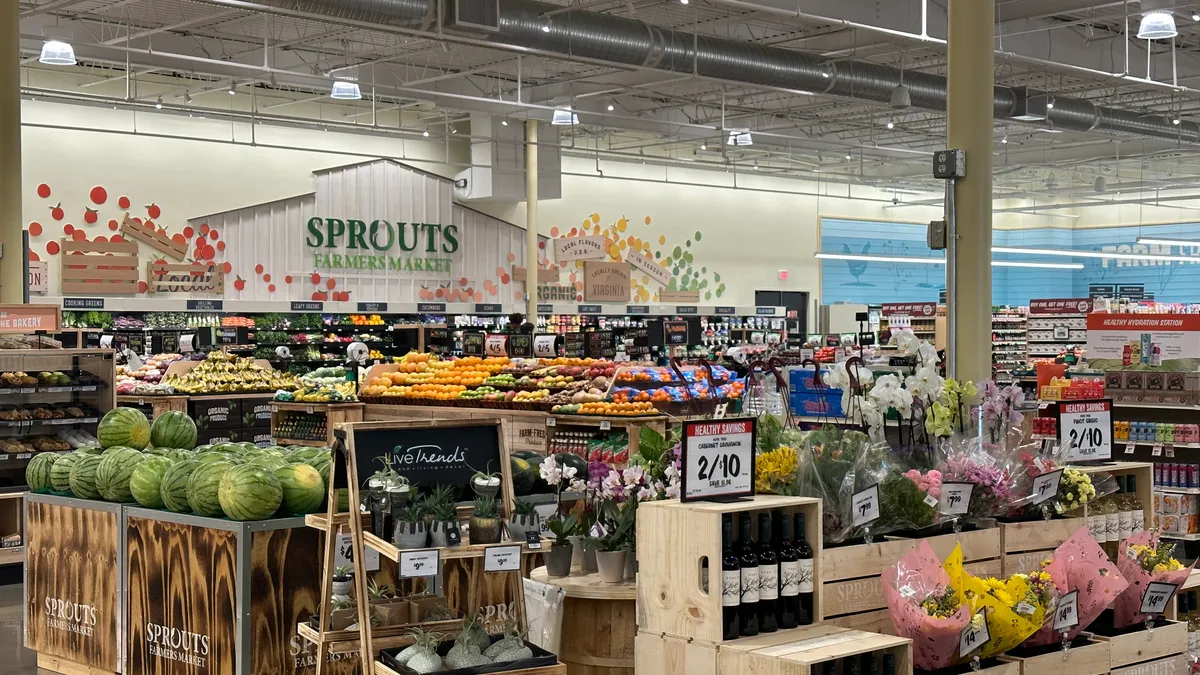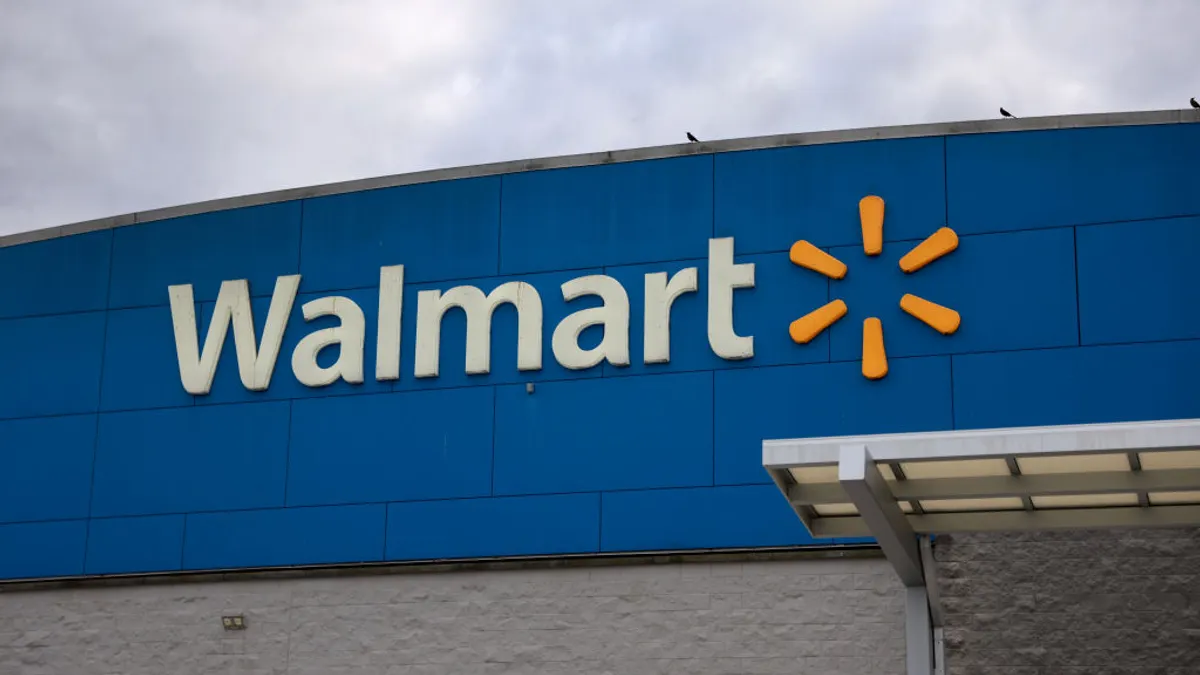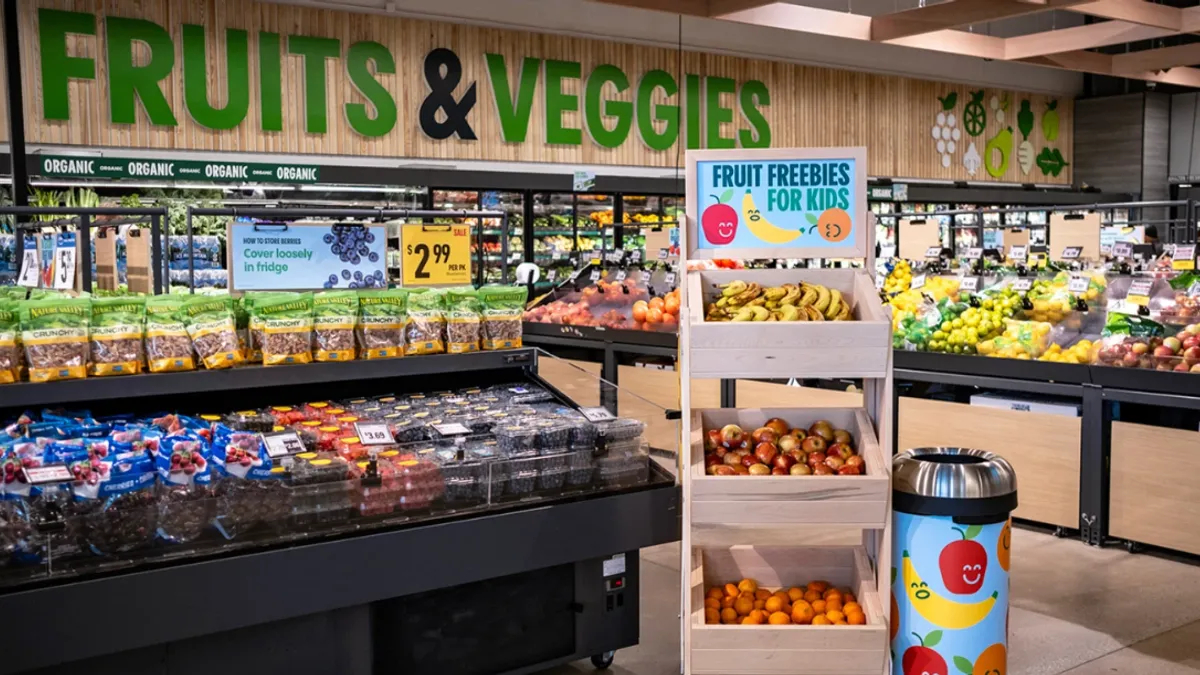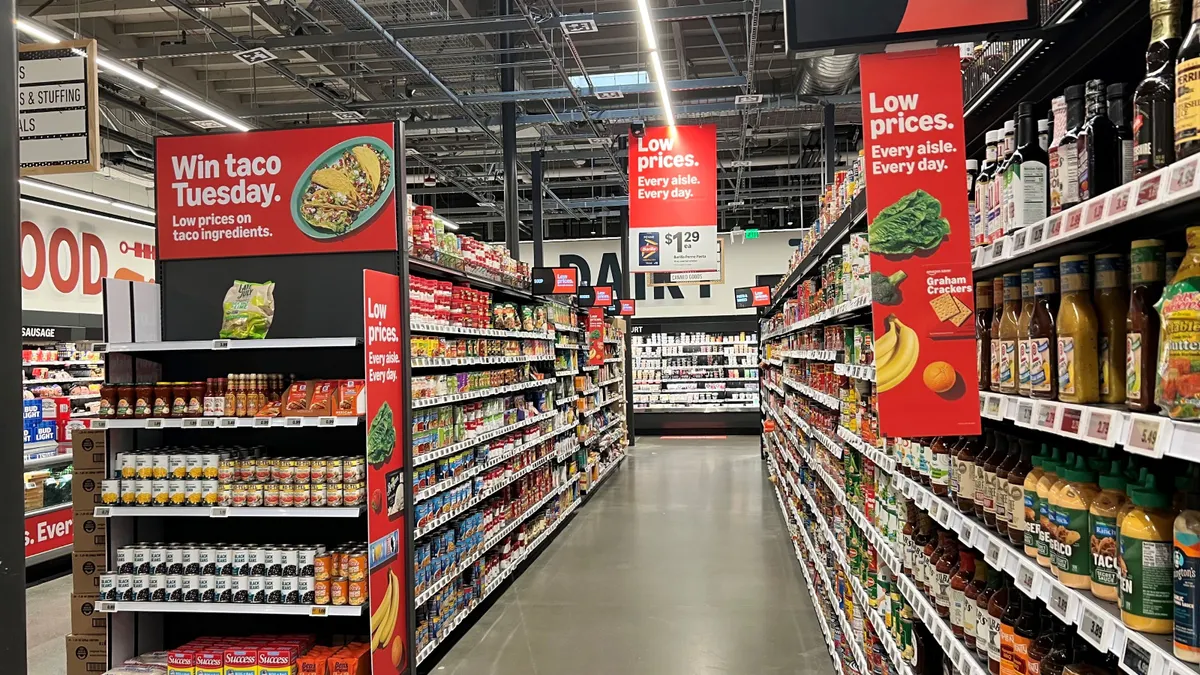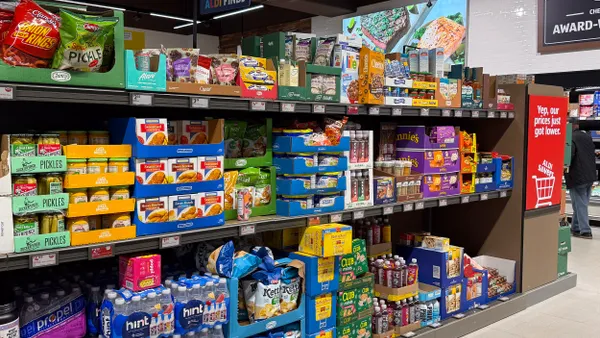Hy-Vee has a reputation for trying new things and staying ahead of the curve. It was one of the first chains to put dietitians in its aisles and now has nearly one in each of its 245 stores. The chain also built out its own e-commerce platform, Aisles Online, and made it available to all stores two years before Amazon bought Whole Foods.
These days, the Midwestern grocer is dabbling in everything from meal kits to clothing aisles and new store concepts. Last year, Hy-Vee opened not one but two different scaled-down store formats — HealthMarket and the new-look convenience store Fast & Fresh. The former features a sports nutrition station and what might be the first grocery store brand hearing aid. The latter is a meal stop where shoppers can fuel up, grab a box of sushi and a growler of beer.
Randy Edeker, Hy-Vee's straight-talking CEO, doesn't see the company as a major innovator or risk taker. To him, it's continuing to build on its legacy strengths and defending its turf in communities ranging from large metros to small towns with just 2,000 people. Grocery Dive sat down with Edeker recently and had a wide-ranging discussion on everything from the growth of Hy-Vee's Market Grille restaurants to the company’s struggles to hold on to workers.
This interview has been edited for length and clarity.
Grocery Dive: Hy-Vee's HealthMarket and Fast & Fresh stores are brand new, with just one location each. But there seems to be high hopes for expansion here. Starting with HealthMarket, which opened last summer in Des Moines — what led to the development of that concept and how have shoppers responded?
Edeker: There's a lot of talk over what the store of the future is going to look like. I don't think anybody knows, but we know we have to experiment a little bit. Those formats are coming just [by] looking at what works in our big stores. HealthMarket is our natural and organic section that we've had for 25 years. That's been very successful, so what we wanted to do was pull that out of the store and partner that with an overall health view, from Orangetheory Fitness to pharmacy to hearing aids to the walk-in clinic, sports nutrition, vitamins and supplements, and put that all in one place.
If you look at drugstores right now ... I don’t think the drugstore format is necessarily working. So can we reinvent the drugstore format for certain markets? It's really an alternative store, and we're going to see if it can work.
What's the runway for growth with HealthMarket? Is it still 50 to 60 stores?
Edeker: I don't know. I want to do one right now to see how that goes. If I look at Omaha, Minneapolis, Des Moines and Kansas City, I think there could be eight or 10 of those in each one of those big markets. We're going to test it for a while. I have two other locations where we're thinking about building one.
There are some things we would do different, for sure. It might be slightly bigger. We would re-engineer the front end. We're going to move to a self-checkout only front end there in the next few months. The core customer, the customer that loves HealthMarket is the person that's going to go to the kombucha bar, and they love it.
Hy-Vee is pretty deep in convenience stores with over 150 locations. Why build a different format in Fast & Fresh?
Edeker: One in five meals are eaten in the car, the average meal takes 12 minutes to prepare and 60% of women say that they don't know what they're going to eat for dinner at 4 p.m. And so we're seeing Fast & Fresh as an expanded c-store, but it's an expanded c-store with a very fresh focus to try and bring meal solutions to people while they're going home. If you look at how we designed it, most have a Starbucks or a coffee shop on one side and then we have some traditional c-store elements with a much-expanded wine and spirits department in it, some hot food options to go, and then we have meal solutions.
It's a meal replacement store. It's a place to go when I don't know what's for dinner tonight and I don't want to go to the big store.
How do you plan to scale Fast & Fresh compared to HealthMarket?
Edeker: [Fast & Fresh] we're moving a little faster on just because we're established in the c-store business. We have 15 Fast & Fresh [stores] on the budget this year. Those will range from 6,500 square feet to a couple that are 10,000, but most of them are closer to the 6,500 square feet.
Where will those stores appear?
Edeker: They'll be in our larger metro areas. So I have a couple in Kansas City, you'll have several in Des Moines, a few in Minneapolis and then the one that we have in the Quad Cities is the first — it's up and going.
As a company, what do you need to have in place in order to be able to experiment like this?
Edeker: I think you have to do the best you can to study and learn. Learn from others, learn from their mistakes. Most corporations don't want to have any failings, us included. But I've told my folks before, if we're not failing we're not trying hard enough. So first you have to have the passion and the will, and then you have to have the resources and be willing to say, okay, if we mess up this could be costly.
You asked about HealthMarket. Yeah, I'd like to have 60, but we're going to have one good one first. We have to prove ourselves out or not. And that's the same with Fast & Fresh.
"There’s a lot of talk over what the store of the future is going to look like. I don’t think anybody knows, but we know we have to experiment a little bit."

Randy Edeker
CEO, Hy-Vee
So many other grocers have dabbled in restaurants, but Hy-Vee has more than 100 Market Grilles attached to its stores. What have been some keys to operating a business that's so different from grocery?
Edeker: That's the first thing — it's very difficult. Labor is challenging, finding people is challenging. And then you're dealing with how do we overcome the stigma of meeting in the grocery store? So you try to make the experience not feel like a grocery store. The genesis of it was simply, food away from homes surpassed food at home. So as we looked at that we thought, how are we going to fill that customer's need?
Keep in mind we've always had very well-established foodservice since the '60s. If you went to a Hy-Vee store back then, we did full fresh breakfast in the hot cases. So in some regards, it's a defensive measure just to keep what we had.
How do you see the Market Grille and Market Grille Express concepts evolving over the coming years?
Edeker: Every store with the exception of our really, really small stores will have a Market Grille or a Market Grille Express. Our intention with the full-service Market Grilles is to really have one or two per big town. The cities we have more than that because they're spread out. In Des Moines, we'll have two or three with full service and the rest will be Market Grille Express. It's kind of like Chili's and Chili's Express — just keeping those options in the store. But some locations will have full service and some won't, and some of that's just based on the size of the area, of the store.
You're also building more than two dozen Wahlburgers restaurants. Why jump into the franchise business right now?
Edeker: It came naturally. We already had a partnership with Mark [Wahlburg] around Performance Inspired [workout supplements]. That had gone really well. Mark was a real credible business person and really, I would say, honorable. There are huge demands on his time and yet he's always there when we need him. And so he and I just started talking about it. We looked at how we diversify our brand as far as the restaurant business goes, but also how we take that brand and use the excitement and the celebrity, frankly, to drive people into our stores.
We're going to have one Wahlburgers, maybe two, in the state of Iowa. That's it. In other markets, we're bringing Wahlburgers into our stores as Market Grille: Home of the Wahlburger. We've opened three [Wahlburgers] and we have three more on the budget this year. We'll keep building those out.
Hy-Vee invested it in its own e-commerce business early. Why invest in your own platform like that rather than farm that out to a third-party service?
Edeker: There's an expectation of us as far as service with our customers, and we've seen that play out time and time again. We're partners with Instacart and Shipt at the customer's request. They can use Instacart and Shipt both through their site for the two-hour delivery and so forth, but the bulk of the business still comes through Hy-Vee Aisles Online. And we're reinvesting in Aisles Online. We think it's just best for us to own it and go that direction and manage it from what we think our brand expectations are.
What are the challenges of operating that e-commerce business and what have the challenges been in scaling it?
We went into it with a perception of looking at what others have done. We've learned our customer base expects different. We went in with 13,000 SKUs and said this is 97% of the business, and our customers very clearly showed us that the expectation is to have more than that. So we've added SKUs, and that's driven business up. We've obviously had many learning curves around delivery slots and times and how to expand it.
The thing that we know now is, really the bulk of the businesses is in a few stores in certain parts of each town. We know that we need to move that out of the retail stores and have it more in a fulfillment-type center, and we're working at those right now. So we're doing a central fulfillment model. We'll have that in Minneapolis and in Omaha, Lincoln [Nebraska] and Kansas City by the end of the year. You really have to bring efficiency to it. You look at the percentage of the total business in the U.S., it's growing exponentially, but it's still not a big portion of our total volume yet.
Is there any evaluation around automation or using dark stores to fulfill orders?
Edeker: We've evaluated fully automated centers, semi-automated centers, robotics, you name it. Ours will be semi-automated. They'll take a bulk of cost out, but they're not fully automated like some folks are doing. Frankly, as we put a pencil to it we just can't see that working out for us right now.
We also have a plan to use our fulfillment centers as an extension of our infrastructure to deliver. We have 155 c-stores and we'll have 177, maybe 179, by the end of the year. And so we see the fulfillment centers in those markets having a dual purpose of serving as an each-pick facility. We're already going to be out doing deliveries, and we see that there are some synergies there that we can use as part of a distribution system.
What do you see driving e-commerce demand from consumers right now?
Edeker: I think it's a bit of a fickle customer. I think people want e-commerce, and if you look at the statistics, at how many people have used e-commerce — it's a big number. How many people use it every week? That's a much different number.
I think it's something that people want to have when they want it. In our household, we'll be an e-commerce customer sometimes. And then we're not other times, and it comes down to convenience and time. I think that's what e-commerce is about: Having an efficient system that's dependable, easy to use when I don't have time to go to the store or there are things I don't want to go to the store for. We have a core group of customers that shop every single week. I think that will continue to grow.
"People I think look at it like, wow there's just a lot of innovation happening at Hy-Vee. And it's really defending the turf we already had."

Randy Edeker
CEO, Hy-Vee
There's a lot of action in the Twin Cities these days. What sort of opportunity do you see to grow there?
Edeker: We think that we have a place there and that what we do is good and different and it fits. We've slowed growth up there just a little bit, and that's really because we're spending money in other places. E-commerce is one. We have a dozen stores in Kansas City planned to be completely refreshed with many of our new concepts. As we evaluate our budget as a $10 billion dollar company, we have to sit there and say okay, what do we have to spend and where is the best place to spend it?
We have two stores under construction in the Twin Cities, Maple Grove and Spring Lake Park. That will be it for this year and then we'll look at two or three stores next year. Typically, we'd be focused on building four or five stores, but right now we've invested a lot in [store] refreshes and a lot in Fast & Fresh and in fuel. We think that the Twin Cities is still a market where we’ll have 20, 25 stores over the next several years, and that's our target right now.
What are the focus areas for Hy-Vee with its store remodels?
Edeker: Expanding foodservice and in-store dining is part of it. We have our Mia Pizza line, which is our wood-fired, oven-fresh Neapolitan style pizza that we’re making. It's our Hibachi grill and our Nori Sushi, making sure that we're updated in all those spots to evolve the food and keep it growing. If we don't have artisan bread, we're putting in our artisan bread oven. Produce isn't changing dramatically, but we are refreshing produce.
Then it's really looking at more GM and nonfood options. We're looking at reinvigorating our candy department, working with some partners on increasing seasonal space, looking at expanding clothing and then really expanding more into home goods where it makes sense. And then we're rethinking the front end. You'll see a lot of self-checkout coming in, and that's something we've probably been a little slow to do. But where we've launched will self-check it's like, immediate adoption. We tried self-check three times before and it just did not work well with customers, and now that tide has turned.
Hy-Vee has always been focused on consumer health. What does that focus look like these days?
Edeker: I think that people in large part are managing their own health more and more. I think just because of the expense of health and health coverage, there is a need there. We think that our position in health has really been to help the customer at the grassroots. That's why we invested in dietitians over the years, and the pharmacist is a huge part of that, too. One of the most trusted people in healthcare is the pharmacist.
I said a long time ago with dietitians, if you save somebody a nickel on pork and beans, they'll love you for a minute. But if you save the life of a loved one they'll love you forever. And so from a strategy standpoint health makes sense. And then from a business standpoint, health makes sense.
How would you say Hy-Vee is doing as a company hiring and workers at a time of very low unemployment?
Edeker: I think that's an area we have to dramatically improve quickly, to be frank. I launched a group that looked at our benefits starting over a year ago, looking at how do we evolve and what do people want today? And then how do we adapt that to a retail setting? Iowa is the lowest unemployment state now officially in the United States, and so it's very difficult.
We've had to evaluate Market Grille and Market Grille Express. You can see every restaurant up and down our streets with a [hiring] sign in their front yard. We've adjusted pay in many of the markets. I think we're doing several things to get better, but I'm not comfortable that we're doing enough.
We're working on a very aggressive tuition assistance program. We haven't launched anything yet, but this is something that I've been working on for some time. I've hesitated because I want to do it right and so we're at work on that. The other thing I think is that we just have always been flexible. Flexible with part-time folks, flexible with our full-time folks. We'll just keep looking at how we continue to improve.
Hy-Vee has been experimenting with smaller stores, but will the company shrink its traditional stores?
Edeker: I think that we'll build somewhat smaller stores. To say that I'm 100% sure would just not be true. We’ve done some experimenting with that. We opened a 56,000-square-foot store in the Twin Cities and we got lots of comments saying, 'We thought it'd be like this other store we really like.' I think we have to find a way to make sure that we have everything that delights the customer inside it. And then we'll decide that size.
How much pricing pressure are you feeling right now with Walmart and Aldi in so many of the markets you're in? How are you responding?
Edeker: There's real pressure. What's interesting is there's more pressure in some of our small rural towns than in the cities. We've had to adjust pricing. We have adapted three stores to a format called Dollar Fresh, and it is really a lower price, lower-service store trying to match up with Walmart and Aldi out in some of those small towns, because we have some Aldis in towns of 7,000. One of our stores is in a town of 2,000 that has a Fareway, a Walmart Supercenter and a Dollar General. So you have to be focused on price with that mix. We just decided we're not going to be the high-priced option, and we’re not.
You also have to look at the demographics of the area you're in. There are parts of Iowa and northern Missouri that are just not in economically great shape. We've had to be more focused on price just from the customer base.
At this point, what do you think will define Hy-Vee in 2019?
Edeker: For me, it is definitely refreshing Hy-Vee stores. We're in towns of 2,000 people, so how do you keep those stores viable and fresh? You just can't forget about them. We're trying to make sure that we keep those stores up for the communities that were in because they're usually a county hub. So we're refreshing those stores in a cost-effective way and then going back into our big stores and making sure that we're as good as we ought to be, and that we have all the bells and whistles that the customer wants today.
That's my number one focus on the budget. Number two would be e-commerce, for sure. And then number three would be the Fast & Fresh, seeing just how do we build the meal solutions and that one-stop shop on the way home when customers don't know what to do for dinner tonight.







